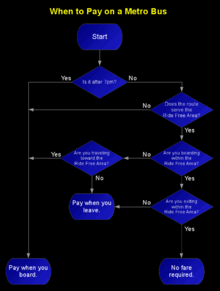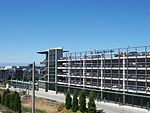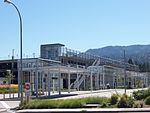- King County Metro
-
King County Metro 
Slogan We'll Get You There Parent King County Department of Transportation Founded January 1, 1973 Headquarters 201 S. Jackson St., Seattle Locale King County, Washington Service area King County, Washington Service type Transit bus Alliance Sound Transit Routes 223[1] Stops 9,549[1] (year-end 2008) Hubs 13 transit centers Fleet 1,443[1] (year-end 2008) Daily ridership 400,457[2] Fuel type Diesel, Diesel-electric hybrid, Electric trolleybus Chief executive Kevin Desmond, General Manager Web site Metro Online King County Metro, or Metro for short, is the public transit authority of King County, Washington, a division of the King County Department of Transportation. It began operations on January 1, 1973, but can trace its roots to Seattle Transit, founded in 1939, and Overlake Transit Service, founded in 1927. As of 2008, it operated 1,443 buses on 223 routes.[1] Its annual ridership in 2008 was 118 million.[3] By first quarter 2009 ridership figures, Metro is the 8th largest agency in the nation.[4] Metro employs 2,694 full- and part-time operators (year-end 2008)[1]
Contents
History
The Municipality of Metropolitan Seattle, or Seattle Metro, was created by a local referendum in 1958 authorized to manage regional wastewater and water quality issues in King County.[5] After two failed attempts to enable it to build a regional rapid transit system, it was authorized to operate a regional bus system in 1972. The bus system was known as Metro and began operations in 1973. Its operations subsumed Seattle Transit, formerly under the purview of the City of Seattle, and the Metropolitan Transit Corporation, a private company serving suburban cities in King County. The Municipality of Metropolitan Seattle was overseen by a federated board of elected officials in King County. After its representation structure was ruled unconstitutional in 1990, and a popular vote in 1992, the municipality's roles and authorities were assumed by King County government.[5] After completion of the downtown Seattle Transit Tunnel project, attention was drawn again to developing a regional rail system. This interest led to the formation of the Central Puget Sound Regional Transit Authority, also known as Sound Transit, which holds primary responsibility for planning and building high capacity transit in the counties of King, Pierce and Snohomish, in western Washington state.[6] Metro Transit continues to provide local and regional transit service connections, primarily within its jurisdictional boundaries. Besides its own transit operations, Metro operates ST Express bus and Central Link light rail service for Sound Transit.[7]
Operations
Routes
See also: List of King County Metro bus routesMetro combines service patterns typical of city and suburban bus networks. The city network, descended in large part from the Seattle Transit system of converted streetcar routes, is arranged in a hub-and-spoke pattern centered on downtown Seattle, with lesser amounts of crosstown service. Routes in the city network are numbered from 1 to 79, with special late-night "Owl" routes in the 80s and the waterfront streetcar and its replacement route numbered 99 even though the bus route is now like any other Metro service. Because of the scattershot evolution of the system, there is no easily discernible pattern to the route numbers, although there are clusters in certain neighborhoods: for example, the 43, 44, 45, 46, 48, and 49, as well as the 65, 66, 67, 68, 70, 71, 72, 73, 74, 75, and 79 all run through the University District (U-District).
The in-city routes with the highest ridership are the 7, traveling from downtown Seattle through the International District and Rainier Valley; the 36, traveling from downtown Seattle through the International District to Beacon Hill; the 43 and 49 (the latter of which was formerly the northern portion of route 7), traveling through Capitol Hill to the University District; the 44, a crosstown route connecting the University District and Ballard; the 48, a long crosstown route connecting north Seattle and the University District to the Central District; and the 3 and 4, connecting downtown to Queen Anne, First Hill, the Central District, and Madrona. However, because of the bus-only nature of the system, there are many other heavily used routes.
The suburban system is more numerically organized. Roughly speaking, areas south of the city from Burien and Des Moines through Renton and Maple Valley are served by routes numbered from 101 to 197. Areas east of the city from Renton to Bothell are served by routes numbered from 200 to 291. Areas north of the city from Bothell to Shoreline are served by routes numbered from 301 to 373. Numbers in the 400s and, for the most part, the 800s, are reserved for Community Transit (Snohomish County) commuter routes serving Seattle; numbers in the 500s are used by Sound Transit's Regional Express system, save for Pierce Transit's routes 500 (Federal Way-Tacoma) and 501 (Federal Way-Milton-Tacoma). 600 series routes are general "express" routes that are used for special purposes (the 630, for example, operated between the Kingsgate Park and Ride and Bellevue during construction of the Totem Lake direct access ramps) as well as the Olympia Express Lines operated by Pierce Transit and Intercity Transit, and 900 series routes are reserved for Dial-a-Ride services and for routes serving outlying areas such as Duvall and Carnation.
Special routes numbered 206-208, 219 and 885-890 are used by Metro to serve Bellevue School District students. Special coaches are dispatched around the region to serve as shuttles for local events, including Seattle Mariners baseball games, Seattle Seahawks and Washington Huskies football games, and other special events.
Major all-day Metro routes in the suburbs include the 120, connecting Seattle and Burien; the 124 connecting downtown Seattle and Tukwila; the RapidRide A line connecting Tukwila and Federal Way in the busy Pacific Highway/International Blvd. corridor; the 150, connecting Seattle, Southcenter and Kent; the 101 and 106 between Seattle and Renton; the 255, connecting Seattle and Kirkland; the 240, connecting Renton and Bellevue; the 230 and 253, connecting Bellevue, Crossroads, and Redmond; the 271, connecting Issaquah, Bellevue, and the University District; the 347 and 348, connecting Northgate and North City; and the 358, operating on Aurora Avenue N. to Shoreline.
Freeway Express Services
Metro operates many peak-hour commuter routes serving park and rides that use 244.52 miles of the region's network of High Occupancy Vehicle (HOV) lanes.[8] This practice was pioneered at Seattle Transit as the Blue Streak express bus service running between Northgate Park & Ride and Downtown Seattle. Special stops called "freeway flyers" or freeway stations were constructed to allow efficient transfer between local and express buses.[9] The first "freeway flyer" stop opened in 1975 at Montlake Boulevard and State Route 520.[10] Metro also takes advantage of new HOV direct-access ramps and freeway stations constructed by Sound Transit to improve speed and reliability of its commuter routes.[11][12]
Ride Free Area
To encourage transit usage, improve accessibility and encourage downtown shopping, a portion of downtown Seattle was cordoned as the "Magic Carpet Zone" in 1973, allowing for zero-fare rides within the area.[13][14] Today, it is called the Ride Free Area (RFA), and fares are not collected between 6 a.m. and 7 p.m. within the area. The RFA extends from the north at Battery St. to S. Jackson St. on the south, and east at 6th Avenue to the waterfront on the west.[15]
On routes that originate in the Ride Free Area and terminate outside of it, passengers pay their fare when they exit the bus at their destination. On routes that originate outside the RFA and terminate within it, passengers pay their fare when they board.
Routes 2, 3, 4, 14, 64, 303 begin and end outside of the Ride Free Area, with others changing their route number as they travel through the RFA. Passengers that board the bus before it enters the ride free area and plan to alight outside of the RFA should obtain a transfer ticket while paying fare upon boarding. The transfer will be shown to the operator as they alight because the bus will switch to collecting fares as passengers exit after exiting the RFA. Metro routes 116, 118 and 119 are not included in the RFA.[16]
A King County Auditor's Office report released in September 2009 found that Metro "can neither fully explain nor provide backup documentation for the operating cost savings that offset the fare revenues in the calculation of the annual charges to the City of Seattle for the city's Ride Free Area" and that some assumptions in the methodology Metro used to calculate the amount of lost fares was "questionable" and have not been updated to reflect changes to the fare structure and fare collection methods.[17]
A 1975 study found that while the Ride Free Area generally reduced bus travel times within the RFA itself, buses that traveled through the Ride Free Area to other destinations generally did not benefit. It also found that unloading outbound coaches once outside the RFA took additional time, though not entirely quantified vis-à-vis time saved within the RFA.[citation needed]
Skip-Stop Spacing
Metro uses Skip-stop spacing on 2nd, 3rd, and 4th Avenues in Downtown Seattle, whereby buses skip every other bus stop. On 3rd Avenue, each bus route is assigned to Blue, Yellow, Red or Green stop groups and each bus stop has two color designations; in the northbound direction, every other bus stop is a Red/Yellow or Green/Blue stop, while in the southbound direction they are Green/Yellow and Red/Blue. On 2nd and 4th Avenues, routes are grouped into Orange and White stops. The bus stop color groupings are identified by a colored plate installed above the bus stop sign. On 3rd Avenue only, there are additional colored markers one block ahead of each bus stop on the trolley overhead wires, to help bus drivers identify the colors of the upcoming bus stop.[18]
Wi-Fi
As of November 2008, Metro provides free Wi-Fi service to its passengers on the following routes:
- 197 (Twin Lakes P&R/University District)
- 255 (Downtown Seattle/Kirkland, Brickyard P&R)
- 644 (temporary route, replaced by 244: Overlake/Kenmore)
- 952* (Kennydale, Auburn/Boeing Everett)
*Available on last AM peak hour trip and last PM peak hour trip
Metro uses a cellular air card from Sprint which is plugged into a Junxion Box. The system is currently set up on 48 coaches. Metro advertises that the SSID is KingCountyMetro.[citation needed] Initially these coaches had exterior markings, however many of these have been replaced with advertisements. Coaches continue to sport large stickers on the ceiling near the front of the coach.[19][20][21]
In the February 2009 service change, there is no longer any mention of free Wi-Fi service in timetables for the above routes, resulting in the discontinuation of the Wi-Fi service. However, the service returned on the new RapidRide service, the first line of which, the A Line, began service in October 2010.[22]
Operating Costs
The cost per boarding for Metro was $4.10 in 2005, compared to $2.50 among the 15 largest national agencies and $2.97, the national average. Metro's cost per boarding is 38% above the national average.[23]
Metro's higher-than-average cost per boarding can be at least partially attributed to its high percentage of "commuter" routes, which run at peak hours only, and often only in one direction at a time. As of 2011, 100 of Metro's 223 routes are peak-only. These routes require significant deadheading (particularly on the one-way routes), as well as a very large part-time labor force, both of which drive up costs[24].
Metro's lowest cost route overall, route 4 (East Queen Anne to Judkins Park), had a cost per boarding of only $0.46 during peak hours in 2009. By way of contrast, Metro's peak-only route with the lowest cost per boarding was route 206 (Newport Hills to International School), at $2.04. Metro's highest cost route by this measure, route 149 (Renton Transit Center to Black Diamond), had a peak time cost of $34.47 per boarding. Route 149 serves the rural southeastern corner of King County.[25]
In 2007 it cost $3.64 per boarding to deliver service in the West (Seattle) subarea, $4.79 in the South subarea and $7.27 in the East subarea of King County.[23] At the end of 2008, the systemwide cost per boarding was $3.70.[1]
MEHVA
Metro maintains a special fleet of historic motorbuses and trolley buses which are occasionally operated on special excursions. These coaches are restored and operated by the Metro Employees Historic Vehicle Association (MEHVA), a non-profit organization formed in 1981.[26] MEHVA is a group of volunteers who are current or retired Metro employees and non-employees who help to restore and operate the historic coaches and pay the cost of some parts. The first excursions took place in 1984, and nowadays MEHVA normally operates six to eight per year.[26] Each excursion has a different route and a different emphasis. There are excursions for trolley buses and excursions for motorbuses. The historic coaches are stored and maintained at various Metro bases (garages) in the Seattle area.
The historic fleet consists of motorbuses and trolley buses ranging from ones built in the late 1930s and early 1940s through to ones retired only recently, such as a Breda dual-mode bus,[27] a type which was used for tunnel routes and replaced with hybrid electric buses. The collection of vehicles is occasionally expanded. Many retired transit vehicles which were formerly operated in Seattle were either scrapped or auctioned off and bought by private citizens. Quite often these privately owned vehicles were abandoned and left on the owner's property for many decades until found and acquired by Metro and added to their fleet of historic transit vehicles, one such example being a 1919 Birney streetcar from the original Seattle streetcar system which operated until 1941. The 1919 Birney streetcar is the only known car left from the Seattle streetcar system.[citation needed] An MAN articulated trolleybus from Metro's fleet, retired in 2007, was acquired by the Illinois Railway Museum in 2008[28] and now operates occasionally on the museum's trolley bus line.
Facilities
Downtown Seattle Transit Tunnel
Main article: Downtown Seattle Transit TunnelA major Metro operations facility is the Downtown Seattle Transit Tunnel, or DSTT. The DSTT, a 1.3-mile-long, five-station tunnel through the center of downtown Seattle, was completed in 1990 at a cost of $455 million.[29] Planned from the outset to be convertible to light rail operation, the tunnel was outfitted with rails and overhead trolley wire. A fleet of 236 dual-propulsion buses were produced by Breda of Italy, powered by electric traction in the tunnel, and diesel on city streets. Mode changes occurred at the north and south portals.
The tunnel suffered some significant problems in operation, as the Breda buses proved overweight and unreliable. The original plan to have up to 489 dual-powered buses using the tunnel by the mid-1990s never materialized; the 236 Breda buses were the primary buses to use the tunnel until Metro acquired its hybrid fleet in 2004.[29][30]
The tunnel was closed in 2005[31] to replace the rails, lower the track bed for Central Link's modern ADA-compliant light rail vehicles, and complete a stub tunnel for the University Link extension to the north. The tunnel finished its retrofit and returned to service on September 24, 2007.[31]
In addition to Central Link Light Rail, the Downtown Seattle Transit Tunnel currently serves the following bus routes during tunnel operating hours: King County Metro 41 (Northgate, Lake City), 71 (U-District, Wedgwood), 72 (U-District, Lake City), 73 (U-District, Jackson Park), 74 Express (U-District, Sand Point), 76 (Green Lake P&R, Wedgwood), 77 (Maple Leaf, Jackson Park, North City), 101 (Renton), 102 (South Renton, Fairwood), 106 (Rainier Beach, Renton), 150 (Southcenter, Kent), 212 (Eastgate), 216 (Sammamish, Bear Creek P&R), 217 mornings only (Eastgate, N Issaquah), 218 (Eastgate Freeway Station, Issaquah Highlands P&R), 255 (Kirkland, Brickyard P&R), 301 (Richmond Beach, Aurora Village), 316 (Green Lake P&R, NSCC, Meridian Park) and Sound Transit Express 550 (Bellevue).[32]
Transit Centers
Transit Centers act as smaller regional hubs that are served by many bus routes. Some transit centers are located in a park-and-ride lot. While Downtown Seattle is Metro's main transit hub, Metro operates out of thirteen transit centers[verification needed] located throughout King County[33]:
Location Year Opened Notes 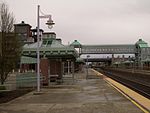
Auburn 2000[34] Aurora Village 1985[35] 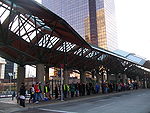
Bellevue 1985[35] Owned 51% by Sound Transit, 49% by Metro[33] 
Burien 2009[36][37] 5 electric vehicle recharging stations[38] Eastgate 2004[39] 3 electric vehicle recharging stations[40] 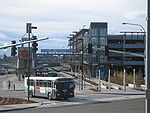
Federal Way 2006[41] Issaquah 2008[42] Kirkland 1986[43] Renovated 2011[43][44] 
Mount Baker 2009[45] Connection to Mount Baker Station 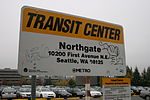
Northgate 1992[46] 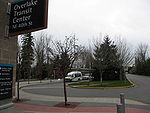
Overlake 2002[47] 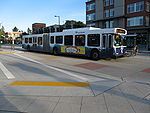
Redmond 2008[33] 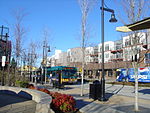
Renton 2001[48] 
Totem Lake 2008[49] At Evergreen Medical Center There also exist transfer points which are transit hubs that lack their own facilities.
Park and Rides
In King County, Metro has 132[1] Park and Ride facilities containing a total of 24,524[1] parking stalls. Half of the lots are leased from other property owners such as churches.[33]
Bases
Metro operates out of seven bases (garages), spread throughout its 2,134-square-mile (5,530 km2) operating area:
Name Location Year Opened Notes 
Atlantic 1555 Airport Way S, Seattle[50] 1941[51] Only base that serves electric trolley buses[51] 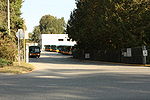
Bellevue 1790 124th Ave NE, Bellevue[50] 1983[citation needed] 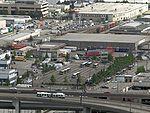
Central 640 S Massachusetts St, Seattle[50] 1941[51] 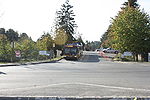
East 1975 124 Ave NE, Bellevue[50] 1977[10] 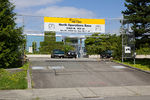
North 2160 N 163rd St, Shoreline[50] 1992[52][53] Built mostly underground[52] 
Ryerson 1220 4th Ave S, Seattle[50] 1987[35] 
South 12100 East Marginal Way S, Tukwila[50] 1978[10] More coaches here than any other base[54] (as of Sep 2003) Atlantic, Central, and Ryerson Bases are located close together near Safeco Field south of downtown Seattle and are known as the Central Campus.[54] East and Bellevue bases comprise the Bellevue Campus[54] and are located nearby each other in north Bellevue. The South and East transit facilities finished an ADA retrofit in 2001.[citation needed]
Other
Name Location Year Opened Notes 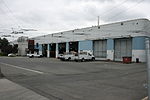
Atlantic Maintenance 1555 Airport Way South, Seattle[55] 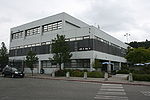
Central/Atlantic/Ryerson[54] Operations 1270 6th Ave S, Seattle[55] 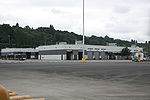
Central Maintenance 640 South Massachusetts, Seattle[55] 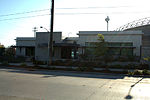
Communications Control Center 1505 6th Ave S, Seattle[55] 2007[56] 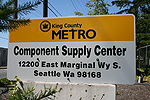
Component Supply Center 12200 East Marginal Way South, Tukwila[55] 
Employee Parking Garage 1505 6th Avenue South, Seattle[55] 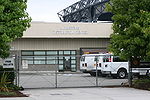
Marketing Distribution Center 1523 6th Ave South, Seattle[55] 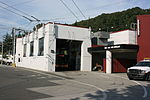
Tire and Millwright Shop 1555 Airport Way South, Seattle[55] 
Power Distribution 2255 4th Avenue South, Seattle[55] 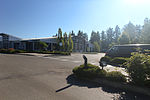
Redmond Van Pool Center 18655 NE Union Hill Road, Redmond[55] 2002[57][verification needed] Van Pool van storage[58] 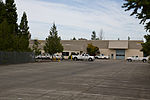
South Facilities 11911 East Marginal Way South, Tukwila[55] 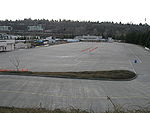
Training and Safety Center 11911 East Marginal Way S, Tukwila[59] Operator training, new equipment qualifications, and retraining.
Across the street from the South Base.Transit Now
In April 2006, King County Executive Ron Sims announced a program entitled "Transit Now" that, if approved by voters, would provide for a 20 percent increase in transit service by the end of 2016 over 2006 service levels, measured in annual operating hours. In order to realize this growth, Transit Now proposed an increase in the local option sales tax for transit of one-tenth of one percent. The Transit Now ordinance,[60] passed by the King County Council on 5 September 2006 and signed by Executive Sims on 11 September 2006, forwarded the tax proposition to the voters and identified the programs to which operating revenue generated from the sales tax increase could be appropriated. The measure was approved by 56.62% of King County voters in the November 2007 general election. The service programs identified in the ordinance are as follows:
- Implementation of Bus Rapid Transit (BRT) service called RapidRide in five arterial corridors.
- Increase service on high ridership routes that provide frequent, two-way connections throughout the agency's service area.
- Service for growing areas in outlying sububuran/[exurban] areas.
- Partnerships with cities and major employers to provide more service than could otherwise be provided through typical resources.
- Additional improvements such as expanded ride-share and paratransit services in King County.
RapidRide
Main article: RapidRideAlso see Bus Rapid Transit
The RapidRide corridors are:
- "A" Line (Opened October 2, 2010[61]) - Pacific Highway South. This line connects with Sound Transit's Central Link light rail beginning at the Tukwila, WA, Park and Ride (Tukwila International Boulevard Link Light Rail station) and travels along Pacific Highway South to Federal Way via SeaTac, Washington.
- "B" Line (Opened October 1, 2011) - Bellevue-Redmond. The line serves the Bellevue TC in downtown Bellevue, NE 8th Street, Crossroads Mall area, Overlake and downtown Redmond at the Redmond TC.
- "C" Line (2011) - West Seattle. The line will run from West Seattle Junction over the West Seattle Bridge to downtown Seattle.
- "D" Line (2012) - Ballard-Uptown. The line will serve Ballard, Uptown and the downtown Seattle Stadium Area.
- "E" Line (2013) - Aurora. This line will run from Pioneer Square, Seattle in downtown Seattle to the Aurora Transit Center in Shoreline by way of Aurora Avenue North.
- "F" Line (2013) - Southcenter Blvd. This line will run from Burien Transit Center to the Renton Transit Center serving Tukwila International Boulevard Station, Southcenter Mall, Tukwila Sounder Station, South Renton Park and Ride in between.
All lines will use new, low-floor, articulated buses that feature an identifiable look distinct from other Metro coaches. Stops will be farther apart than typical Metro service to increase speed and reliability and create "stations" more akin to what is found on light rail lines. Stations will have real time information signs to communicate estimate arrival times of RapidRide buses.[62] Some form of off-bus fare collection would be considered.
Intelligent transportation systems (ITS)
Collaborating with several local jurisdictions, Metro was an early experimenter with Transit Signal Priority (TSP), a system to extend green lights to allow buses to get through. The system can boost average speeds as much as 8%, and is in use on several of the city's busiest corridors, including Aurora Avenue North, Rainier Avenue S, and Lake City Way NE.[63]
In 2010, Metro will rollout a new IP network based ITS infrastructure for its RapidRide service. Buses will communicate with roadside equipment using 802.11 wireless technology on the 4.9 GHz public safety band. A fiber optic backhaul connects access points and roadside equipment together to Metro's Communication Center. The system will extend the legacy RFID-based TSP system. It will also be used in conjunction with GPS technology to provide frequent and accurate location updates for next bus arrival signs at RapidRide stations. Those signs are a component of what Metro calls a "Tech Pylon", a free standing wireless-capable kiosk, that also has an ORCA Card validator and other rider information.[64][65]
Metro is a participating agency in the regional smart card program called ORCA (One Regional Card for All). It was launched for public use on April 20, 2009, along with six other transit agencies in the region.[66]
Metro plans to have automated stop announcements on buses beginning in late 2009 as part of its on-board communications system update.[67]
In 1998 the fleet was updated with a Automatic Vehicle Location (AVL) system that utilizes battery-powered beacons located at some stops. Metro is currently in the process of replacing it with a GPS-based system as part of a system-wide radio update by 2010.[68]
The extent of Metro's application of intelligent transportation systems (ITS) for transit information available for customers has been limited to a few projects:
- An early project called MyBus by the University of Washington (UW) utilized the tracking data to provide real-time bus information. This is now hosted by Metro under the name Tracker. An improved version of MyBus called One Bus Away, developed by a UW graduate student, combines Tracker information with Google Maps.
- Transit Watch displays, like those found in airports and major train stations, are installed at some transit centers and transfer points to show real-time bus arrival information.
- A pilot project provided bus information displays along a city arterial. Metro discontinued the project in 2005, citing the cost of maintenance and technical problems.[69]
- Metro has a regional trip planner that provides itineraries for transit trips within King, Pierce, and Snohomish counties, including those on Sound Transit services, Washington State Ferries, the Seattle Center Monorail, and the Seattle Streetcar. Google Maps also provides trip planning using schedule data as part of their Google Transit service but it is limited only to Metro bus routes.
Programs
- Adopt-A-Stop
- Bus Shelter Mural Program
- Move It! Youth Project
- Partners in Transit
- Poetry on Buses[70]
- Recycling Program
- School Program
- Central Puget Sound Regional Fare Coordination Project (Smart Card)
- On-Board Systems/Communications Center System Project
Fleet
Metro operates one of the largest bus-only fleets[71] in the country. Metro has a high concentration of articulated buses—almost half its current fleet and the largest articulated fleet in North America.[71] Metro's use of articulated coaches dates back to 1978, when it was the first large agency in the country to adopt the technology.[citation needed] The other half of the fleet consists of mostly Gillig Phantom high-floor coaches and New Flyer low-floor coaches, the latter of which are used mostly on routes within the Seattle city limits.
The agency pioneered technologies in widespread use today. In 1979, the AMG trolleys were ordered with some of the first wheelchair lifts in the nation,[citation needed] promising a completely new level of independence for disabled residents. Early lifts were severely flawed, but by the mid 1980s the lifts were generally reliable and were ordered on all new buses. With the retirement of the 1400-series buses in 1999, the entire fleet became wheelchair-accessible—again, the first fleet its size to do so.[citation needed] Metro was reluctant to adopt low-floor buses, not buying any until 2003. Low-floor coaches have slightly reduced seating capacity (because the wheelwells intrude further into the passenger compartment) which may have been a concern as many of Metro's routes are frequently "standing room only".[citation needed] Whatever the reason for the delay, Metro has now embraced low-floor buses, and all new fleet additions since 2003 have been low-floor. Like Golden Gate Transit and SamTrans in California's San Francisco Bay area of (and unlike most transit agencies), almost all of Metro's fleet has highback non-reclining seating[citation needed] as opposed to lowback seating that is used by most other transit agencies on local routes. These buses operate on both local and express routes.
Trolleys
 A Gillig Phantom trolley on route 4
A Gillig Phantom trolley on route 4
Metro maintains a fleet of 159 electric trolley buses (ETBs) that serve 14 routes[72] along almost 70 miles[1] of two-direction overhead wire. This is the second largest ETB system (by ridership,[73] number of routes and fleet size) in the country.[74] The ETBs are valued by Metro both as zero-emission vehicles,[75] and as vehicles well adapted to Seattle's hilly terrain. In Seattle, ETBs are traditionally referred to simply as "trolleys". Occasionally Metro will use diesel or diesel-electric hybrid coaches on trolley routes. Reasons for doing this include construction (weekends only[76]), overhead wire maintenance or events that require coaches to go off-route (Metro's ETBs do not have emergency power units), "coach changes" (replacing a bus in service that has developed a problem), or to add temporary additional capacity. The latter two cases sometimes lead to diesel buses being used, in order to get the replacement or supplementary vehicle into service as quickly as possible; diesel buses can reach the point of entry into service faster, as they do not need to follow the overhead wires when deadheading.
In 2002, Metro replaced its 109 AMG trolleys with 100 new trolleys using new Gillig Phantom shells. The drive train of the AMG coaches was retained with new electronics, saving approximately $200,000 per coach. Metro rebuilt 59 of the 236 now retired dual-mode Breda "tunnel buses", converting them to electric-only operation and refurbishing them to replace aging MAN articulated ETBs. The rebuild included new Vossloh-Kiepe current-collection equipment, new interior upholstery, a completely new driver's compartment, and new LED destination signs.
Diesel-Electric Hybrids
Metro operates the largest fleet of articulated hybrid buses in the country, the fleet of 235[1] New Flyer DE60LFs it purchased to replace the Bredas (Sound Transit bought an additional 21 similar buses). Metro's hybrids were purchased to run in the Downtown Seattle Transit Tunnel, where they operate together with Sound Transit's light rail vehicles. Metro purchased 213 hybrids in 2004, and by March 2006, Metro had accumulated nearly 13 million miles on its 235 hybrid buses.[77] On May 16, 2007, Metro awarded its biggest contract ever to New Flyer for the purchase of 715 more 60-foot (18 m) hybrid buses.[78] Ninety-three[79] 40-foot hybrid coaches from Daimler Buses North America were ordered in 2009 with delivery expected in 2010.
The National Renewable Energy Laboratory (NREL) conducted a one-year comparative study between conventional diesel and GM hybrid-powered buses operating on a typical King County drive cycle. Results showed that the GM-hybrid powered buses lowered fuel consumption by 23%; NOx by 18%; carbon monoxide (CO) by 60%; and total hydrocarbon (THC) by 56% when compared to conventional diesel buses.
Hush Mode
A special mode was designed by GM Allison engineers to allow the buses to operate solely on electric power, reducing tailpipe emissions and noise.[77] Before entering the tunnel, the operator pushes a button that charges the batteries to their maximum charge and puts the coach into "Hush mode". In the bores between the tunnels, the bus uses electric traction to get to 15 mph (24 km/h); after 15 mph a combination of electric and diesel is used. The operation of the diesel engine allows the batteries to charge. Inside the stations, the coaches operate solely on electric propulsion. While the doors are closed, the engine still rotates in order to operate auxiliary loads (such as the air compressor). Hush mode is deactivated after the coach has traveled a certain distance or can be manually deactivated by the operator.
Current Fleet Roster
Manufacturer Model Image Engine/Transmission Propulsion Year Fleet Series Quantity Under 30 Feet Ford/Champion van Challenger 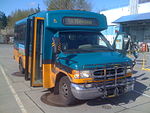
Navistar T444E/Ford 4R100 Diesel 2003 1200-1234 35 Workhorse/StarTrans President LF 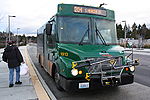
GMC Duramax/Allison 1000 series Diesel 2010 1900-1934 35 30 Feet Gillig Phantom 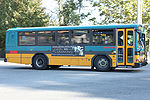
Cummins ISC/Allison B400R Diesel 1999-00 1100-1194 95 35 Feet Gillig Phantom 
Cummins M11/Allison B400R Diesel 1997 3185-3199 11 40 Feet Gillig Phantom 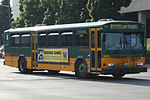
Cummins M11/Allison B400R Diesel 1996-99 3200-3594 395 Gillig Phantom ETB 
GE/Alstom (reman) Electric-trolleybus 2002 4100-4199 100 New Flyer D40LF 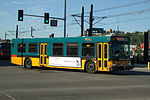
Cummins ISL/Voith 864.3 Diesel 2003 3600-3699 100 Orion 07.501 (VII)
Next Generation HEV
Cummins ISB/BAE Systems HybriDrive Diesel-electric 2010 7000-7092 93 60 Feet Breda DuoBus 350 
AEG/Westinghouse Electric-trolleybus (Converted)
2004-20074200-4258 59 New Flyer D60 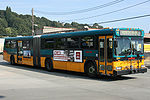
Cummins M11/Allison B500R Diesel 1998-99 2300-2573 274 New Flyer DE60LF 
Caterpillar C9/GM Allison HybriDrive Diesel-electric 2002 & 2004 2599-2812 214 New Flyer D60LF 
Caterpillar C9/Allison B500R Diesel 2004 2870-2899 30 New Flyer DE60LF 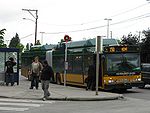
Cummins ISL/GM Allison HybriDrive Diesel-electric 2008-09 6813-6865 52 New Flyer DE60LFA 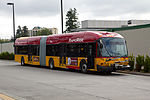
Cummins ISL/GM Allison HybriDrive Diesel-electric 2009 6000-6019 20 New Flyer DE60LFR 
Cummins ISL9/Allison EP-50 HybriDrive Diesel-electric 2011 6866-6930 65 New Flyer DE60LFR Cummins ISL9/Allison EP-50 HybriDrive Diesel-electric 2011 6020-6199 180 Retired Fleet Roster
Model Motor Seated
CapacityLength Purchased Retired Qty.* Fleet Numbers 
Breda ADPB 350 DDC6v92TA/
AEG/Westinghouse56 60' 1988–1991 2005 236 5000-5235 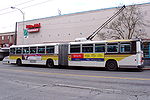
MAN ETB Siemens[citation needed] 64 60' 1987 2007 46 4000-4045[80] MAN Americana MAN D2566 MLUH 44 40' 1986–1987 2004 157 3000-3146; 3150-3159[81] MAN SG-310 MAN D2566 MLUM 60' 1983 2001 202 2000-2201[82] MAN SG-220 MAN D2566 MLUM 60' 1977 1999 151 1400-1550[82] 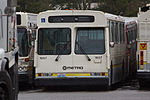
Flyer D900 Cummins VTB903 40' 1979 1997 224 1600-1823[83] Flyer D900 Cummins VTB903 35' 1980 1997 35 1850-1884[83] 
AMG 10240T GE 45 40' 1979 2003 109 900-1009 (no 911)[84] AMG 10240B8 DDC 8V71 40' 1976 1996 323 1100–1313; 1340-1349[84] 
GMC T8H-5305 DDC 8V71 40' 1968 1987 70 700-769[85] Flxible Detroit Diesel 6V-71 51 40' 1963 1985 100 500-599[86] 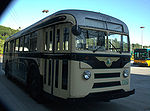
Brill Trolley 40' 1940 1963[87] References
- ^ a b c d e f g h i j "Facts". King County Metro. 2009-04-16. http://www.kingcounty.gov/transportation/kcdot/MetroTransit/Facts.aspx. Retrieved 2009-07-09.
- ^ Sims, Ron (August 28, 2008). "Huge increase in Metro bus riders". http://ronsims.wordpress.com/2008/08/28/huge-increase-in-metro-bus-riders/. Retrieved 2009-01-08.
- ^ King County,Metro bus and van ridership set another record in 2008, 2009-02-05.
- ^ "APTA Ridership Report: First Quarter 2009 - Bus Agencies, Largest" (PDF). Public Transportation Ridership Statistics. American Public Transportation Association. 2009-06-08. http://www.apta.com/research/stats/ridership/riderep/documents/09q1bus.pdf. Retrieved 2009-07-31.[dead link]
- ^ a b HistoryLink.org Online Encyclopedia of Washington State History, "Metro: Municipality of Metropolitan Seattle" (by Kit Oldham), http://www.historylink.org/ (accessed February 15, 2009).
- ^ Sound Transit. History and Chronology. October 2007.
- ^ Light rail operator Ordinance
- ^ Washington State Department of Transportation. Summary of Public Transportation - 2007. November 2008.
- ^ Chapter 2. Bob Lane, Better Than Promised: An Informal History of the Municipality of Metropolitan Seattle (Seattle: King County Department of Metropolitan Services, 1995) http://dnr.metrokc.gov/wtd/docs/better_than_promised/ch02.pdf
- ^ a b c King County Metro. Transit Milestones 1970s
- ^ King County Department of Transportation. New transit/HOV ramps now open at Eastgate 2007-03-07.
- ^ Sound Transit. ST Express Regional Bus Projects and Related Projects
- ^ Walt Crowley (1993). "Metro Transit establishes free Magic Carpet zone in downtown Seattle in September 1973". HistoryLink.org Online Encyclopedia of Washington State History. http://www.historylink.org/index.cfm?DisplayPage=output.cfm&file_id=2698. Retrieved 2009-10-12.
- ^ Robert Lindsey (September 9, 1973). "Seattle Joining Movement for Free Bus Rides". The New York Times. p. 228. http://select.nytimes.com/gst/abstract.html?res=F60A10F63A59137A93CBA91782D85F478785F9&scp=1&sq=1973%20Seattle%20free%20bus%20service&st=cse. Retrieved 2009-10-12.
- ^ Metro Transit Ride Free Area
- ^ Route 116 Special Fare Collection Info
- ^ [1]. King County Auditor's Office, September 15, 2009. Retrieved September 15, 2009.
- ^ http://metro.kingcounty.gov/up/sc/rideralert/2011/feb/
- ^ "Metro bus riders can sample Wi-Fi as part of extended pilot project". 2007-04-05
- ^ "Metro bus riders test county's first rolling WiFi hotspot". 2005-09-07.
- ^ Text transcript of Metro WiFi buses video. 2005-09-07
- ^ http://www.kingcounty.gov/transportation/kcdot/NewsCenter/Reports/RapidRideFactSheet.aspx
- ^ a b Review of Metro Transit, Municipal League of King County (November 2008) [2]
- ^ Public Transit and the Time Based Fare Structure[3], p29-32, sections "Peaked Demand for Transit Service Creates Operational Inefficiencies", "Scheduling Labor to Accommodate Peak Demand is More Expensive", & "Part-Time Transit Employees May Cost More in Long Run"
- ^ 2009 route performance report[4]
- ^ a b Tan, Vinh (15 October 2009). "Take a ride down memory lane — or to see fall foliage — aboard a vintage transit bus". The Seattle Times. http://seattletimes.nwsource.com/html/outdoors/2010064974_nwwbus15.html. Retrieved 2010-06-16.
- ^ Our Fleet. Metro Employees Historic Vehicle Association. Retrieved 2010-06-16.
- ^ Trolleybus Magazine (UK) No. 280 (July–August 2008), p. 83. ISSN 0266-7452.
- ^ a b Crowley, Walt (2000-10-01). "Metro transit begins excavating downtown Seattle transit tunnel on March 6, 1987". HistoryLink.org. http://www.historylink.org/index.cfm?DisplayPage=output.cfm&file_id=2700. Retrieved 2009-11-29.
- ^ Noble, Alice (May 14, 1987). "New Metro bus: Smart move or a bad bet?". The Seattle Post-Intelligencer. http://www.seattlepi.com/archives/1987/8701120368.asp. Retrieved 2009-12-05.
- ^ a b "Downtown Seattle Transit Tunnel to reopen Sept. 24" (pdf). September, 2007. http://metro.kingcounty.gov/up/sc/rideralert/pdf/TunnelReopeningFINAL.pdf. Retrieved 2009-03-04.
- ^ "Metro Bus Tunnel". March 26, 2008. http://metro.kingcounty.gov/tops/tunnel/tunnel.html#intunnel. Retrieved 2009-10-28.
- ^ a b c d "2007 Annual Management Report" (pdf). King County Department of Transportation. 2007-12-14. http://metro.kingcounty.gov/am/reports/2007/2007-QMRyearend.pdf. Retrieved 2009-02-14.
- ^ "Transit". City of Auburn, Washington. http://www.auburnwa.gov/community/Getting_Around/Transit.asp. Retrieved 2009-07-16.
- ^ a b c King County Metro. Transit Milestones 1980s
- ^ "Burien Transit Center". King County Metro. 2008-12-29. http://www.kingcounty.gov/transportation/kcdot/MetroTransit/BurienTransitCenter.aspx. Retrieved 2009-07-16.[dead link]
- ^ "Burien Transit Center". King County Metro. 2009-05-25. http://www.kingcounty.gov/transportation/kcdot/NewsCenter/TransportationToday/2009/tt052509_burien.aspx. Retrieved 2009-07-16.
- ^ "Park & Ride Lots - South Seattle". King County Metro. http://metro.kingcounty.gov/tops/parknride/pr-south-seattle.html. Retrieved 2009-07-16.
- ^ "New Eastgate Park-and-Ride garage opens June 5". King County Metro. 2006-05-24. http://your.kingcounty.gov/kcdot/news/2004/nr040526_eastgate.htm. Retrieved 2009-07-16.[dead link]
- ^ "Park & Ride Lots - East Side". King County Metro. http://metro.kingcounty.gov/tops/parknride/pr-eastside.html. Retrieved 2009-07-16.
- ^ Sound Transit. Federal Way Transit Center/S. 317th
- ^ "Metro Schedule and Route Revisions, May 2008". King County Metro. http://metro.kingcounty.gov/up/sc/rideralert/ra-052008-rtchanges.html. Retrieved 2009-07-16.
- ^ a b Sound Transit. Kirkland Transit Center
- ^ "Kirkland Transit Center temporary closure". King County Metro. http://metro.kingcounty.gov/tops/parknride/ra-091009-kirklandtc.html. Retrieved 2010-08-27.
- ^ "Mount Baker Transit Center Opens Sept 19". King County Metro. 2009-09-09. http://metro.kingcounty.gov/up/sc/rideralert/ra-092009.html#mtbaker. Retrieved 2009-10-27.
- ^ Lane, Bob (May 27, 1992). "Not Quite Your Average Bus Stop -- Design And Usefulness Meet At Metro's New Northgate Transfer Center". The Seattle Times. http://community.seattletimes.nwsource.com/archive/?date=19920527&slug=1494090. Retrieved 2009-02-14.
- ^ Sound Transit. Overlake Transit Center/NE 40th
- ^ "New Renton Transit Center & Parking Garage Options". King County Metro. 2001. http://metro.kingcounty.gov/up/sc/rideralert/ra-092001-rtc.html. Retrieved 2009-07-16.
- ^ "Totem Lake Transit Center/Evergreen Medical Center". Sound Transit. http://www.soundtransit.org/x1359.xml. Retrieved 2009-02-14.
- ^ a b c d e f g Addresses of Metro Bases
- ^ a b c "Expanding Atlantic/Central Bases". Metro Transit. Transit Facility News. 2001, Summer.
- ^ a b "Slabs Of Concrete Today; A Bus Barn Soon". Carpio, Nina. The Seattle Times. 1990-02-07.
- ^ "New Metro Bus Base Will Open June 8". Aweeka, Charles. The Seattle Times. 1991-05-17.
- ^ a b c d "OBS/CCS Business Requirements" (PDF). King County Metro. 2003-09. http://www.metrokc.gov/procurement/rfpdocs/2004/June/GoodsAndServices/04-001/Part_C_Sec1.pdf. Retrieved 2009-05-21.
- ^ a b c d e f g h i j k "Invitation to Bid" (PDF). King County Metro. 2007-06-28. http://procurement.kingcounty.gov/procurement_OVR/rfpdocs/2007/GoodsAndServices/McKinley/1000-07/1000-07.pdf. Retrieved 2009-06-24.
- ^ "A Tradition of Performance - King County Department of Transportation". www.metrokc.gov. http://www.metrokc.gov/kcdot/news/myr/myr2008metro.htm. Retrieved 2009-03-27.
- ^ "Assessor information for parcel number 0625069016". King County GIS Center. http://www5.kingcounty.gov/kcgisreports/property_report.aspx?PIN=0625069016. Retrieved 2009-06-24.
- ^ "RESOLUTION: KING COUNTY METRO TRANSIT DEVELOPMENT AGREEMENT, FILE NO. L090012" (PDF). 2009-02-17. http://www.redmond.gov/insidecityhall/citycouncil/20090217pdfs/AM09028.pdf. Retrieved 2009-06-24.
- ^ "Metro's training staff rolls seven days a week". 2008-06-16.
- ^ King County Ordinance 15582
- ^ Viriyincy, Oran (2010-04-22). "RapidRide Information Board". http://www.flickr.com/photos/viriyincy/4544609836/. Retrieved 2010-04-22.
- ^ "RapidRide". King County Metro Transit. http://www.kingcounty.gov/transportation/kcdot/MetroTransit/TransitNow/RapidRide.aspx. Retrieved 2009-03-30.
- ^ "Transit Signal Priority tests a success,more signal synchronization planned countywide". King County Department of Transportation. 2001-02-15. http://metro.kingcounty.gov/up/archives/2001/tsp.html. Retrieved 2009-02-14.
- ^ "King County Metro Transit ITS" (ppt). King County Department of Transportation. 2008-12-12. http://depts.washington.edu/itswa/2k8MtgPres/AnnualMtg/KCM_ITS_presentation%20for%20ITS%20WA.ppt. Retrieved 2009-05-06.
- ^ "King County Metro Transit ITS" (ppt). Region 43 Regional Review Committees - State of Washington. 2009-04-29. http://www.region43.org/documents/700MHz/20090429MeetingSlides.ppt. Retrieved 2009-05-06.
- ^ ORCA smart card limited rollout gets underway
- ^ Page 3. In Transit Newsletter, July/August 2008 issue. King County Department of Transportation.
- ^ City never responded to Metro's request to plow routes, bus chief says. Emily Heffter. Seattle Times. 2009-01-07. Accessed 2009-05-06.
- ^ "Pilot Project for Real-time Bus Information System on Aurora Avenue North". King County Department of Transportation. 2005-07-12. http://metro.kingcounty.gov/up/archives/2005/ledonaurora.html. Retrieved 2009-02-14.
- ^ The Poetry on Buses program has, since 1992, "inspired residents of King, Pierce, Kitsap and Snohomish Counties to participate in this program that serves as a national model." Selected poems are displayed on interior bus placards, and selected poets receive an honorarium for the poems' use.
- ^ a b Roman, Alex (September/October 2009). "Top 100 Transit Bus Fleets". Metro Magazine 105 (8): p. 22. http://metromag.epubxpress.com/link/metro/2009/sep-oct/1?s=0. Retrieved 2009-11-05.
- ^ Metro, King County (2009-03-16). "Trolley Motorization Status". http://metro.kingcounty.gov/up/rr/m-trolley.html. Retrieved 2009-03-19.
- ^ "APTA Ridership Report: First Quarter 2009 - Trolleybus Agencies" (PDF). Public Transportation Ridership Statistics. American Public Transportation Association. 2009-06-08. http://www.apta.com/resources/statistics/Documents/Ridership/2009_q1_ridership_APTA.pdf. Retrieved 2009-11-17.
- ^ Webb, Mary (Ed.) (2009). Jane's Urban Transport Systems 2009-2010. Coulsdon, Surrey (UK): Jane's Information Group. ISBN 978-0-7106-2903-6.
- ^ Metro Vehicles King County Metro.
- ^ "Trolley buses". King County Metro. 2008-12-05. http://www.kingcounty.gov/transportation/kcdot/MetroTransit/Construction/Trolley%20Buses.aspx. Retrieved 2009-08-05.
- ^ a b Chandler, K; K. Walkowicz (2006-12). "King County Metro Transit Hybrid Articulated Buses: Final Evaluation Results" (PDF). National Renewable Energy Laboratory. http://www.nrel.gov/vehiclesandfuels/fleettest/pdfs/40585.pdf. Retrieved 2009-07-16.
- ^ "New Flyer Receives Order for Up To 715 Buses From King County Metro Totaling Up To US $514 Million"
- ^ "Federal stimulus grant delivers more buses for Metro". Auburn Reporter. http://www.pnwlocalnews.com/south_king/aub/business/50786482.html. Retrieved 2009-08-08.
- ^ "MAN Articulated Trolley Bus". King County Department of Transportation. 2002-09-09. http://metro.kingcounty.gov/am/vehicles/retired/a-trolley.html. Retrieved 2006-07-20.
- ^ "MAN Standard Diesel Bus". King County Department of Transportation. 2003-05-28. http://metro.kingcounty.gov/am/vehicles/retired/diesel.html. Retrieved 2006-07-20.
- ^ a b MAN Products
- ^ a b Flyer & New Flyer
- ^ a b AMGeneral Coaches
- ^ T8H-5305
- ^ Flxible F2D6V-401-1
- ^ Brill 40 SMT
External links
 Media related to Metro Transit (King County) at Wikimedia Commons
Media related to Metro Transit (King County) at Wikimedia Commons- Metro Transit
- One Bus Away
- Metro Employees Historic Vehicle Association (MEHVA)
- Seattle Tunnel on History Link
- Metro Tracker Applications
- mybus.org
- Bus Monster
- Central Puget Sound Regional Fare Coordination
- Metro/Sound Transit Smart Bus Project
- Comparative study between Diesel and GM Hybrid bus fleets operating in Seattle (King County)
- Elliott Bay Water Taxi
Mass transit in the Puget Sound region Local and Express bus Community Transit (list of routes) • Everett Transit • Intercity Transit • Island Transit • King County Metro (list of routes) • Kitsap Transit • Pierce Transit • Skagit Transit • Sound Transit (ST Express) (list of routes) • Trolleybuses in SeattleLight rail Link Light Rail (list of stations): Central Link • University Link • North Link • South Link • East LinkStreetcar Seattle Streetcar Network: South Lake Union Streetcar • First Hill Streetcar • Waterfront Streetcar
Tacoma: Tacoma Link • Tacoma StreetcarCommuter rail Bus rapid transit Swift • RapidRideFerry Guemes Island ferry • Kitsap Transit • Washington State Ferries • King County Ferry District: West Seattle Water Taxi • Port of Kingston Soundrunner • Steilacoom-Anderson Island FerryIntercity rail Monorail Seattle Center Monorail • Seattle Monorail Project (defunct)Other Italics denote lines or services which are planned, under construction, or otherwise not operating at the present time. Categories:- Sound Transit
- Bus transportation in Washington (state)
- Bus rapid transit in Washington (state)
- Government of King County, Washington
- Transit authorities with hybrid buses
- Transit authorities with alternative-fuel vehicles
- Transportation in King County, Washington
- Transportation in Seattle, Washington
- Zero-fare transport services
Wikimedia Foundation. 2010.


